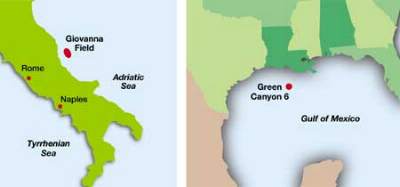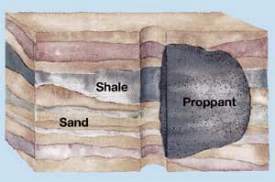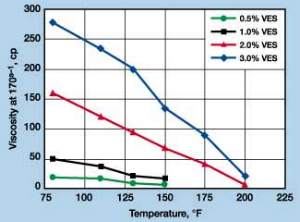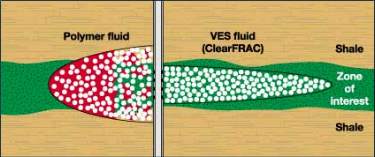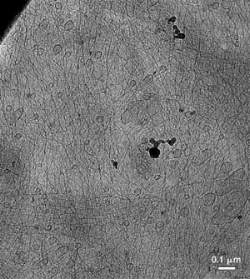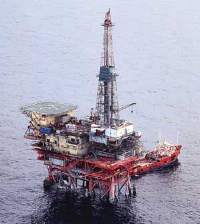Seawater in polymer-free fluids optimizes fracturing offshore
PRODUCTION TECHNOLOGYSeawater in polymer-free fluids optimizes offshore fracturingTwo projects have demonstrated that seawater can be mixed successfully with a polymer-free viscoelastic surfactant in a fracturing fluid system, to enhance production while simplifying the process, saving time and reducing costEnzo Pitoni, Eni / Agip; Bradley D. Marple, Texaco E&P, Inc.; and Norbert Heitmann and Mathew Samuel, Schlumberger
Results were achieved by using seawater with ClearFrac, a polymer-free, viscoelastic surfactant (VES), fracturing fluid system. How this system works and highlights of both the Eni / Agip and Texaco applications are detailed. Eliminating The Polymer Problem To reduce offshore stimulation costs and simplify fracturing operations, the concept of using seawater as a base fluid is not new. There have been noted attempts to mix polymer-based fluids with seawater on the fly, but treatment results have varied widely. To gel effectively, polymer fluids need a specific mixing environment with distinct pH windows – crosslinking normally requires a high pH. However, the divalent metals present in seawater interact to form hydroxides and lower polymer fluid pH, making it less stable. While no simple, seawater-compatible polymer system currently exists, a polymer-free VES fluid has been mixed successfully with seawater in two areas of the world – the Italian Adriatic Sea and the U.S. Gulf of Mexico, Fig. 1. In both areas, the seawater-based VES fluid attained the desired rheological properties to successfully fracture stimulate several moderate-to-high-permeability offshore wells. The fluid achieved tip screen-out (TSO) and desired fracture widths within the defined stress boundaries.
Unlike polymer systems, the polymer-free VES fluid’s gelling is independent of pH, thus the interacting divalent cations in seawater do not negatively affect its rheological properties. In fact, these surfactants can even be used to gel acids. Selecting Fracture Fluids The productive reservoirs in Eni / Agip’s Giovanna field, Adriatic Sea, and Texaco’s Green Canyon 6, Gulf of Mexico, are depositionally similar. Both contain deepwater turbidites that consist of interbedded sand and silt layers. The Pleistocene I-series sands at Green Canyon 6 are among the youngest in the Gulf of Mexico. They are typical turbidites, in that they have fairly clean, coarse, basal sand sequences that grade upward into fine, silty sequences. Average permeabilities range from 25 to 50 md. Unlike at Green Canyon, Giovanna field’s turbidites have significant amounts of clay interbedded among numerous sand and silt streaks – up to 50% clay in some rock samples. While these "dirtier" sequences yield lower average permeabilities (12 md) than typically measured at Green Canyon, both fields have similar fracture stimulation objectives. Their sand layers have to be connected with a single, highly conductive fracture that bypasses formation damage in order to improve production and extend productive life, Fig. 2.
Historically, Texaco has used guar-based fracturing fluids at Green Canyon, while Eni / Agip’s completion team has relied on filtered brine for offshore fracturing jobs, as well as filtered and sheared brine viscosified with hydroxyethylcellulose (HEC). However, the high concentrations of guar and HEC polymers used in these operations leave filter cake and residues in the fracture, which can reduce proppant-pack permeability and lower stimulation treatment effectiveness.1 An analysis of flowback fluids after hydraulic fracturing, using crosslinked polymer-based systems, determined that only 30% to 45% of the polymers returned from the well.2 This unfavorable recovery behavior is further intensified when treating moderate-to-high-permeability sands, sometimes recovering only 5% to 15% of the polymer fluids during flowback. Creating highly conductive fractures in Giovanna and Green Canyon reservoirs requires a clean, solids-free fracturing fluid that provides sufficient viscosity to suspend and transport proppant into the fracture, yet breaks down into a low-viscosity fluid for clean-up after job completion. After careful study, a fluid with these characteristics was identified for application at both sites. Use of the polymer-free VES fluid, at both Giovanna and Green Canyon, has been found to leave neither a filter cake on the formation face nor residues in the fracture (no skin). These projects now do not require polymer hydration, biocides, buffers, caustic, crosslinkers or breakers to achieve stimulation objectives. When flowing back, the VES fluid breaks upon contact with produced hydrocarbons, or when diluted with other formation fluids. When there might be insufficient hydrocarbons to break the VES fluid, clean-up boosters can also be used, although they were not used in the cases described. The selected VES fluid displays rheological characteristics that help promote TSO development, as well as wide, contained fractures, Fig. 3. Similar rheological behavior is observed when VES fluids are mixed with seawaters collected from different regions around the world. The wide variability in the types and composition of salts in seawater is another reason that prohibits its use with polymer fluids, Table 1. However, the reproducible rheological behavior of the VES fluid, when used with different sources of seawater, makes it more reliable and practical in offshore applications.
Another key feature of the fluid is its favorable leak-off behavior and proppant-suspension capabilities that help to promote TSO and provide large fracture widths, while containing excessive vertical height growth. Thus, water-bearing zones or consecutive fracture collisions are avoided, Fig. 4.3 Eni / Agip, in particular, reports that fractures in its Giovanna wells have been confined within the defined stress barriers. This has been a key to the success of this new fracturing approach.4
Fracture stimulation objectives can be accomplished, only if TSO is obtained and high net pressure is achieved at treatment’s end. TSO occurs not when a fracture no longer grows in length but, rather, when the proppant contributes to its width, packing the existing fracture with maximum proppant concentration. While using conventional fluids, some operators have had problems meeting TSO requirements and, thus, treatment objectives. However, the polymer-free VES fluid has experienced a high success rate in achieving TSO when desired, thereby increasing the likelihood of accomplishing fracture stimulation objectives. VES Fluid Composition / Characteristics The VES fluid described herein is created from a quarternary ammonium salt derived from a long-chain fatty acid.5 It is part of a small group of surfactants that, when in the presence of salts, form long, rod-like micellar structures or aggregates, Fig. 5. When dissolved in brine, the micellar network structure – which has a geometry similar to polymer molecules – resists distortion, creating the mechanism that builds the fluid’s viscosity and viscoelasticity.
As a result, unlike polymer fluids, this system does not require a metal crosslinker. Moreover, altering the micellar structure that creates fluid viscosity can break the VES gel, which occurs upon contact with produced hydrocarbons, formation fluids or contaminants, eliminating the requirements for conventional breakers. Earlier VES fluids could be used only for hydraulic fracturing at reservoir temperatures up to 240°F. However, recent advancements have enhanced fluid performance and increased maximum applicable temperatures to 300°F. This has made the fluid suitable for the low- and high-temperature applications at Giovanna, Green Canyon and many other reservoirs around the world. Strategy For Use Of Seawater-Based VES Fluid By chemical definition, formation of the micelle structures that build a VES fluid’s viscosity and initiate its viscoelastic properties does not depend on, and is not limited to, a specific salt in the base fluid.6 This feature makes the fluid an ideal candidate for seawater-based fracturing operations. Although the presence of a single, dominant salt type is preferred, experience, both in the laboratory and onsite, has demonstrated that fluid rheology is largely determined by the system’s total ion concentration. Adding a variety of salts – such as KCl, NH4Cl, NH4NO3 and MgCl2 – can enhance viscosity development when there is an insufficient amount of NaCl present in seawater. While the concentration of the salt present will affect viscosity build-up significantly, the type of salt will not. There are minimum required and maximum tolerable values for total (all) salt concentrations that must be maintained to ensure viscosity build-up. For example, lab testing of midsummer Adriatic seawater mixed with various KCl amounts determined that the VES fluid system would tolerate a 7% maximum, total salt concentration. As a result, 3% KCl was added for the Giovanna field application, to both stabilize formation clays and maintain favorable rheological characteristics of the seawater-based fluid system. Experience confirms that, for optimum gelling, a VES surfactant requires a base fluid with specific salt concentrations, such as 1% NH4NO3, 3% NH4Cl or 4% KCl. Anything lower than these minimums would require supplementation with additional salts. Specific regional characteristics of seawater should be considered when planning offshore VES-fluid fracturing operations, Table 1. Ocean water salinity will fluctuate, depending on the season and temperature. To ensure appropriate gelling, a seawater analysis is recommended, particularly if additional salts are required. Salinity can be measured easily with a hydrometer, to provide an approximate salt concentration in less than one minute. Chlorides also can be determined by titration, using silver nitrate and potassium dichromate as indicators. When set up with an inexpensive titration kit, the onsite experiment takes 2 min. Microorganisms always present in seawater can cause bacterial growth, the outcome of which can be controlled to some extent by using appropriate inhibitors. However, when VES fluids are used, the need for biocides is eliminated. The high concentration of divalent metal salts present in seawater also can create scaling tendencies when using polymer or VES fluids. Commonly used, scale-control agents are compatible with VES surfactant systems. A Simple System While some polymer-based systems require up to 15 separate additives to obtain desired properties, VES fluids are considerably simpler, two-additive systems. Use of seawater as the base fluid further simplifies an already streamlined fracturing fluid, creating essentially a single-additive system. Only the surfactant and proppant are required for a typical seawater-based, offshore fracture treatment. While seawater might require filtration, the prepared surfactant / seawater fluid system does not. Some polymer-based fluids must be filtered and sheared to remove fish eyes and other impurities, which can be expensive, time consuming and labor intensive. The VES fluid system saves extensively on rig and process time, and minimizes service costs and equipment requirements. Bottom line, VES fluid fracturing requires less equipment, and fewer chemicals, procedures and people on location than are required for polymer-based fracturing fluids. The resulting streamlined, efficient operations reduce overall completion / workover costs, which is especially important in offshore applications. Specifically, a seawater fluid base reduces costs by:
Eliminating dependence on fresh water also allows some prohibitively large, offshore fracturing jobs to be possible, despite the small size of a given rig or platform. When storage space is at a premium, the ability to mix seawater on the fly is a critical bonus. A Flexible System The galactose, mannose or similar sugar components of a polymer-based fluid provide food for bacteria. These organisms will grow rapidly unless biocides are added. They can lead to previously batch-mixed volumes being discarded. VES fluids have no polysaccharides and are not prone to decay or bacterial degradation. VES fluids can be batch-mixed or pumped successfully on the fly. When batch-mixed, VES fluids are robust and can be extended or diluted easily. The fluid’s viscosity can be adjusted up or down simply by adding additional surfactant concentrate or diluting with the base fluid – a nearly nonexistent attribute with pre-mixed HEC or guar gels. This flexibility removes some of the operational and fluid-handling risks normally associated with fracturing, especially in offshore operations. For example, during the Giovanna treatments, fracture fluid viscosity was increased on several occasions by adding a small amount of surfactant to the prepared fluid system. Viscosity development was instantaneous, with minimal labor-intensive activities. Case History: Adriatic Sea A successful, pilot stimulation workover performed last year on Giovanna 6, pool 10, led engineers to recommend a full-scale workover campaign for the field. The Well 6 pilot frac-and-pack performed with the VES fluid system successfully stimulated its dirty, tight sand intervals. This resulted in a normalized flowrate calculated at three times the initial rate and twice the previous wellhead pressure. Based on these encouraging results, the same well was selected for a complete workover along with a second well, Giovanna 12. In all, nine frac-and-packs were performed on Well 6, plus six more on Well 12. However, unlike the pilot frac-and-pack, a seawater base was used for the fracturing fluid system, with methanol and 3% KCl added to enhance clay stabilization. The magnitude of the treatment designs dictated using a product that was compatible with seawater, due to Giovanna’s limited platform space for freshwater storage, Fig. 6. Treatment sizes needed for the larger, wider fractures required to bypass damage and connect sand layers could not have been accomplished without using a seawater-based VES fracturing fluid.
The fluid system was mixed in advance and stored on a supply boat. A programmable optimum-density (POD) blender then was used to mix the seawater / VES fluid with proppant on the fly. In a programmed mode, the POD blender continuously mixed and metered proppant, dry additives, liquid additives and fracturing fluid at the specified density. For all Well 6 frac-and-packs, the prepared fluid was transferred in real time onto the rig for blending with proppant. For the Well 12 frac-and-pack treatments, improved rig space management permitted the fluids – one job at a time – to be stocked on the rig. This alternative set-up was considerably safer in the increasingly rough autumn seas, which prevented a supply boat from positioning itself next to the rig for a given length of time. Because the two wells were successfully stimulated and showed good initial production results, a third well, Giovanna 20, was selected for a complete stimulation workover. Eight VES fracturing jobs were performed, the last two being screenless completions in the upper two layers of the short string of the dually completed well. Often performed rigless, the screenless completion is a technique that provides sand control without the use of downhole screens. Sand control was an objective at Giovanna in addition to stimulation, so proppant flowback had to be tightly controlled to prevent proppant output during oil and gas production.7 Based on prior field experience, proppant flowback-control fibers were used for the job. Together, the fibers and proppant reinforced the pack, impairing its movement and decreasing the risk of producing back proppant. In the three-well program, all of the zones fractured with the seawater-based fluid were successfully stimulated, achieving TSO and large fracture widths within the defined stress boundaries. Using seawater saved an estimated 150 hr of rig time, accounting mainly for the round trips and weather-related downtime that would have been required to load, transport and transfer fresh water for 23 treatments.
GOM Case History To streamline logistics and resolve scheduling problems, a team of engineers recommended using seawater for the VES fracture treatments proposed for a well located in GOM Green Canyon 6. As treatment time for Well A-16 approached, a limited number of stimulation service vessels were available in the region, creating scheduling conflicts with high vessel demand. Not wanting to risk losing rig time while a stimulation vessel serviced several operators (particularly since three treatments planned for two locations would require the vessel to go back to shore at least once for fresh water), Texaco decided to use the seawater-based VES fluid system to perform fracturing treatments. While the company had used VES fluids in the past, it had never used seawater as a fracturing system’s base fluid. The stimulation service vessel traveled to Green Canyon 6 and performed a seawater-based VES treatment on the I-2 sand. The Green Canyon treatments were mixed on the fly in their entirety, which differed from the batch mixing used at Giovanna. The continuously mixed treatment was pumped to completion as designed. The stimulation vessel then left the site, to perform a conventional guar-based treatment at another location using the fresh water in its tanks, and then returned to Green Canyon 6 and performed a second seawater-based VES treatment on the I-1 sand. Using the seawater-based fluid for the two Green Canyon treatments enabled one stimulation vessel to perform three fracture jobs on two different rigs in less than 48 hr. Moreover, use of seawater with the VES fluid in its two jobs saved Texaco 32 hr of rig time, including the time that would have been necessary for the vessel to travel back to the dock and load fresh water. The seawater-based system displayed the desired rheological characteristics, which enabled the successful stimulation of both zones, achieving TSO and contained fractures. Assessment / Future Plans As this article has described, recent fracturing operations conducted by Eni / Agip and Texaco used seawater successfully as the base for a VES fluid system. VES fluids will play a significant role in other challenging fracturing applications, such as coiled tubing clean-out and matrix diversion. Due to inherent rheological properties, VES fluids exhibit lower friction pressures than their conventional fluid counterparts. This ability raises the limits on existing hydraulic fracturing technology with coiled tubing. Friction pressures can be the deciding factor as to whether a fracture stimulation treatment can be placed successfully using small-diameter tubing. Increased friction pressures correlate to higher surface treating pressures, which is the single, most dominant factor limiting the application of hydraulic fracturing through coiled tubing.8 VES fluids play a major role in making coiled tubing / fracture stimulation technology successful. Acknowledgment The authors thank Eni / Agip, Texaco and Schlumberger management for permission to publish this article, as well as the research, field and laboratory personnel of these companies for their dedicated support and hard work that made these projects successful. Special thanks go to Angelo Calderoni at Eni / Agip, and to Paul Price, Will Dyson and Ron Hollier at Schlumberger for their support in implementing the polymer-free VES fluid technology in the Italian Adriatic Sea and in the Gulf of Mexico. Literature Cited
|
||||||||||||||||||||||||||||||||||||||||||||||||||||||||||||||||||||||||||||||||||||||||||||||||||||||||
- Applying ultra-deep LWD resistivity technology successfully in a SAGD operation (May 2019)
- Adoption of wireless intelligent completions advances (May 2019)
- Majors double down as takeaway crunch eases (April 2019)
- What’s new in well logging and formation evaluation (April 2019)
- Qualification of a 20,000-psi subsea BOP: A collaborative approach (February 2019)
- ConocoPhillips’ Greg Leveille sees rapid trajectory of technical advancement continuing (February 2019)

